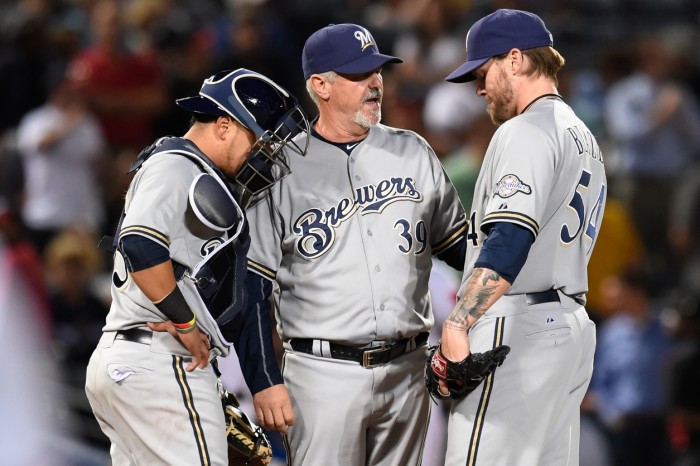One of the few highlights in a dismal season for the Brewers has been its bullpen. Within that bullpen, one of the brighter spots and bigger surprises has been right-hander Michael Blazek. He was the last man added to the bullpen winning the spot out of Spring Training. I won’t lie, either. I thought it was a poor decision at the time.
Blazek’s stuff has never been in question. He features a solid fastball, slider, and curveball mix with good velocity. That’s even a starter’s repertoire. His problem has always been control. Last year for the Brewers Triple-A affiliate, the Nashville Sounds, he had a 9.0 percent walk rate. That was his lowest walk rate since 2010. It also represented the first time since 2010 that he didn’t accumulate a double-digit walk rate.
Technically speaking, he did show some improvement with keeping the ball in the strike zone. Still, I thought congratulating a 9.0 percent walk rate illustrated the overall problem nicely. When Blazek was named to the bullpen, one would have been excused for thinking he would struggle to last a month, walking everyone in sight. Not only has he remained in the bullpen, though, but he’s also been an excellent member of it.
Michael Blazek has made 44 appearances, pitching a total of 55.2 innings. He owns a 2.26 ERA, 2.90 FIP, and 2.00 DRA. The latter two statistics hint at quality peripherals: 21.3 percent strikeout rate, 8.1 percent walk rate, .193 BAA, and 1.02 WHIP. The walk rate is still a bit high, but another personal improvement.
Something remains worrisome, though.
According to PITCHf/x, the league-average rate for pitches in the strike zone (Zone%) is 48.0 percent. Blazek’s Zone% is only 42.4 percent. That is far below average. Batters are only swinging at 41.1 percent of his pitches, too, which is below the league-average rate of 46.9 percent. So he’s missing the strike zone a lot and batters aren’t swinging at a lot of his pitches.
On the surface, that seems problematic; however, three things continue to work in his favor. His 62.4 percent first-strike rate (F-Strike%) is above average (61.0 percent). His 10.7 percent swinging-strike rate (SwStr%) is above average (9.7 percent). And in a related note his 73.7 percent contact rate is much better than average (79.1 percent). Thus, he’s getting ahead of batters and they’re having problems making contact against the pitches at which they offer.
Here’s a bit of an oddity: While batters are swinging at near the league-average rate against pitches outside the strike zone (O-Swing%), they’re only swinging at 52.6 percent of pitches in the strike zone (Z-Swing%). That’s way below the average rate of 64.4 percent. This seems to suggest that Blazek is getting a lot of strikes looking.
Just to reiterate:
- Blazek is missing the strike zone and batters aren’t swinging at many of his pitches;
- But he’s getting ahead of batters early and they’re also having problems making contact;
- And he’s getting a lot of looking strikes.
The natural fear is that batters will eventually become more aggressive against Blazek. However, I don’t exactly know what those looking strikes will turn into. They’ll either become swinging strikes or result in contact. And even then, it’s unclear whether that will be hard or soft contact. The hope here is that the contact issues remain. That would assuredly increase his strikeout rate, which currently sits near the league’s average.
Brewers fans should be encouraged by his ability to miss bats, or rather by hitters’ inability to square up on his pitches. But his inability to pound the strike zone is worrisome. If the walk rate goes up and more aggressive hitters result in more contact, then Blazek could run into significant regression.
The problem is that we’re only working with 56 innings. That’s not nearly a large enough sample size to make definitive assessments of his abilities. I don’t believe that “effectively wild” is a thing. Given enough time, those pitchers’ inefficiencies will be exposed by big-league hitters. Either Michael Blazek’s inability to pound the strike zone will become an issue or his ability to miss bats will be accentuated. Hopefully, the latter will be more predominant. And at least to this point, we have no reason to believe it won’t.
